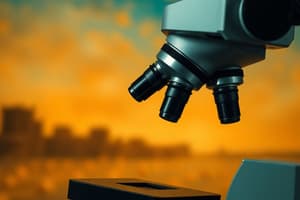Podcast
Questions and Answers
What is the primary function of the eyepiece in a microscope?
What is the primary function of the eyepiece in a microscope?
- To magnify the specimen 10x (correct)
- To illuminate the specimen
- To enhance image clarity
- To provide structural support
Which type of microscope is specifically designed for high-resolution images of thin specimens?
Which type of microscope is specifically designed for high-resolution images of thin specimens?
- Scanning Electron Microscope (SEM)
- Dissecting Microscope
- Transmission Electron Microscope (TEM) (correct)
- Fluorescence Microscope
What does the term 'resolving power' refer to in microscopy?
What does the term 'resolving power' refer to in microscopy?
- The clarity of the image produced
- The degree of specimen enlargement
- The ability to distinguish two separate objects (correct)
- The amount of light supplied to the specimen
When using a microscope, why is it recommended to start focusing with the lowest objective lens?
When using a microscope, why is it recommended to start focusing with the lowest objective lens?
Which component of the microscope is used to focus light onto the specimen?
Which component of the microscope is used to focus light onto the specimen?
What is the total magnification achieved when a 10x eyepiece is used with a 40x objective lens?
What is the total magnification achieved when a 10x eyepiece is used with a 40x objective lens?
What is the purpose of the diaphragm in a microscope?
What is the purpose of the diaphragm in a microscope?
Which adjustment knob is primarily used for precise focusing at higher magnifications?
Which adjustment knob is primarily used for precise focusing at higher magnifications?
Flashcards are hidden until you start studying
Study Notes
Microscope Components
- Eyepiece (Ocular Lens): The lens through which the viewer looks; typically magnifies by 10x.
- Objective Lenses: Multiple lenses on the revolving nosepiece; provide different magnification levels (e.g., 4x, 10x, 40x, 100x).
- Stage: Platform where the specimen is placed; often has clips to hold the slide.
- Illuminator (Light Source): Provides light for viewing the specimen; can be built-in or external.
- Condenser: Focuses light onto the specimen; enhances image clarity.
- Focus Knobs:
- Coarse Focus: Adjusts stage height for general focus (used with low power).
- Fine Focus: Makes precise adjustments for sharp focus (used with higher power).
- Base and Arm: Provides structural support; base stabilizes the microscope, while the arm allows for easy transportation.
Types Of Microscopes
- Light Microscope: Uses visible light to illuminate specimens; includes:
- Compound Microscope: Multiple lenses; high magnification.
- Dissecting Microscope: Low power; used for larger, opaque specimens.
- Electron Microscope: Uses electrons for illumination; includes:
- Transmission Electron Microscope (TEM): High-resolution images of thin specimens.
- Scanning Electron Microscope (SEM): 3D images of surfaces of thicker specimens.
- Fluorescence Microscope: Uses fluorescence instead of reflected light; often used in biological research.
Magnification And Resolving Power
- Magnification: The enlargement of the specimen’s appearance; determined by multiplying the eyepiece magnification by the objective lens magnification.
- Example: 10x (eyepiece) × 40x (objective) = 400x total magnification.
- Resolving Power: Ability to distinguish two close objects as separate; depends on the wavelength of light used and the numerical aperture of the lens.
- Higher resolution provides clearer, more detailed images.
Usage Techniques
- Prepare Specimen: Use thin, flat slices or mounts; ensure adequate lighting.
- Start with Low Power: Begin focusing with the lowest objective lens (usually 4x).
- Use Coarse Focus First: Locate the specimen and use coarse focus to bring it into view.
- Switch to Higher Magnification: Once focused, switch to higher objectives and use fine focus for clarity.
- Adjust Light: Use the diaphragm to regulate light intensity; essential for clearer images.
- Clean Lenses: Always use lens paper to avoid scratches and ensure clear viewing.
Optical Principles
- Refraction: Bending of light as it passes through lenses; key for magnification.
- Lenses: Convex lenses converge light rays to form images; essential for optical microscopes.
- Numerical Aperture: Measure of lens's ability to gather light; higher numerical aperture results in better resolution.
- Field of View: The visible area seen through the eyepiece; decreases with increased magnification.
- Depth of Field: The range of depth over which the specimen remains in focus; typically reduced at higher magnifications.
Microscope Components
- Eyepiece (Ocular Lens): Magnifies the image from the objective lens, typically by 10x.
- Objective Lenses: Multiple lenses mounted on a revolving nosepiece, providing varying magnification levels (e.g., 4x, 10x, 40x, 100x).
- Stage: Platform where the specimen is placed, often with clips to hold the slide.
- Illuminator (Light Source): Provides light for viewing the specimen, either built-in or external.
- Condenser: Focuses light onto the specimen, enhancing image clarity.
- Focus Knobs:
- Coarse Focus: Used for general focusing, especially at lower magnification levels.
- Fine Focus: Used for precise adjustments to achieve sharp focus at higher magnification.
- Base and Arm: Provides structural support, the base stabilizes the microscope while the arm allows for easy carrying.
Types of Microscopes
- Light Microscope: Utilizes visible light to illuminate specimens. It includes:
- Compound Microscope: Employs multiple lenses for high magnification.
- Dissecting Microscope: Utilizes lower magnification for examining larger, opaque specimens.
- Electron Microscope: Uses electrons for illumination, offering higher resolution and detail. It includes:
- Transmission Electron Microscope (TEM): Generates high-resolution images of thin specimens.
- Scanning Electron Microscope (SEM): Produces 3D images of thicker specimen surfaces.
- Fluorescence Microscope: Utilizes fluorescent light instead of reflected light, widely used in biological research.
Magnification and Resolving Power
- Magnification: The enlargement of the specimen's appearance, calculated by multiplying eyepiece magnification by objective lens magnification. Example: 10x (eyepiece) × 40x (objective) = 400x total magnification.
- Resolving Power: The ability to distinguish two closely spaced objects as separate entities. It depends on the wavelength of light used and the numerical aperture of the lens. Higher resolving power translates to clearer, more detailed images.
Usage Techniques
- Prepare Specimen: Use thin, flat slices or mounts, ensure adequate lighting for clear viewing.
- Start with Low Power: Begin focusing with the lowest objective lens (usually 4x).
- Use Coarse Focus First: Locate the specimen and bring it into view using the coarse focus knob.
- Switch to Higher Magnification: Once focused, switch to higher objectives and utilize the fine focus knob for clarity.
- Adjust Light: Use the diaphragm to control light intensity, crucial for achieving clearer images.
- Clean Lenses: Always use lens paper to avoid scratches and maintain clear viewing.
Optical Principles
- Refraction: The bending of light as it passes through lenses, fundamental for magnification.
- Lenses: Convex lenses converge light rays to form images, essential for light microscopes.
- Numerical Aperture: A measure of a lens's ability to gather light. A higher numerical aperture results in improved resolution.
- Field of View: The visible area observed through the eyepiece, which decreases with increased magnification.
- Depth of Field: The range of depth where the specimen remains in focus. It typically reduces at higher magnifications.
Studying That Suits You
Use AI to generate personalized quizzes and flashcards to suit your learning preferences.




